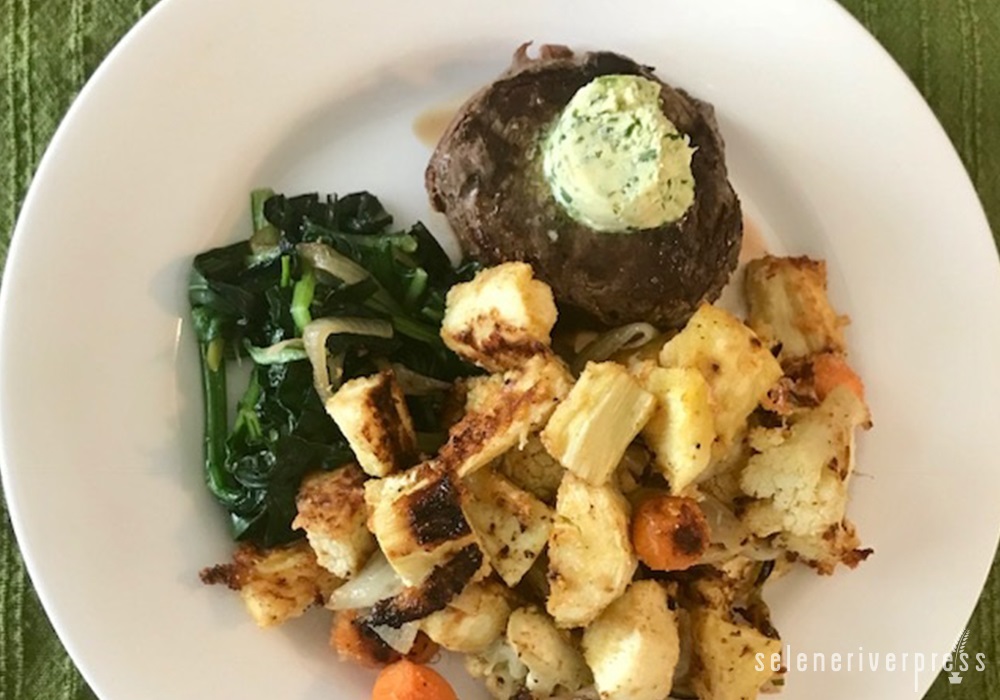People ask me all the time why food at restaurants tastes so much better than what they cook at home. Besides the obvious fact that professional chefs are just better at cooking than most home cooks (it is their job, after all), one of the real secrets, I can guarantee you, is butter. Lots of it.
It’s well known among professional cooks that butter makes just about everything better. This is especially true with traditional French chefs, the pioneers of haute cuisine, as evidenced by their liberal use of the magic stuff. Sadly, butter fell out of favor with the advent of the misconception “animal fats = bad for you.” (This train of thought stemmed from faulty studies and who knows what kind of behind-the-scenes payoffs.) Instead, margarine and other butter alternatives composed of toxic, refined seed oils were touted for years as “healthier.”
Thankfully, people are finally waking up to the fact that natural fatty foods such as butter are extraordinarily healthful, providing hard-to-get fat-soluble vitamins such as A, E, D, and K as well as other nutrients needed for the body to function correctly. As a chef, health nut, and someone who loves butter way too much to ever give it up, I’m happy to know this amazing food adds so much more to my diet than great flavor.
Today, I’m going to let you in on a delicious, convenient, secret ingredient that’s a cinch to make, incredibly versatile, and easily freezable for both instant access and long shelf life. It’s possibly the easiest way to take your food to the next level, without the fuss of having to make a sauce or resorting to some unnatural thing in a bottle. It’s compound butter.
A compound butter is essentially softened butter mixed with aromatic ingredients. Sounds simple, and it is, but you wouldn’t know it from the complexity it adds to your food. The additions can range from a modest combination of parsley and garlic to elaborate concoctions containing items such as reduced wines, vinegars, fragrant spice-and-herb combinations, and even other animal products, such as cheese, bonito flakes, or bacon.
Compound butters add moisture and zest to everything from steamed vegetables to grilled meats to seafood and beyond. They can be mixed into cooked pasta, grains, or mashed potatoes for a flavor burst; they make an insanely good spread for crusty breads and toast or grilled cheese sandwiches; and they can even be melted over grilled fruit for a luscious summer dessert. (While most compound butters are savory, sweet ones are good, too, and just as easy too make.)
Traditionally, a compound butter is made by spooning the mixture of softened butter and flavorings onto parchment paper or plastic wrap and rolling it into a long log. The log is then wrapped, refrigerated until solid, and sliced into individual servings as needed. (A simpler alternative is to just load the butter mixture into a jar and scoop it out as needed.) To freeze it, I cut the entire chilled log into slices, reroll the log, wrap it, and store it in a convenient place in the freezer. This way, I can easily break off a piece without needing to defrost the entire thing.
You can mix the butter and flavorings by hand, of course, but I love the convenience of my mini food processor. It makes the butter extra creamy, too. I prefer to use unsalted butter—from pastured animals, for optimal nutrition—and add salt to my own taste, but you can certainly use salted butter too. Just be sure to account for the salt when you are experimenting with ingredients.
Also, keep in mind the laws of chemistry. Liquids and fats don’t tend to mix well and need to be fully emulsified, or they will separate. For this reason I don’t recommend adding a whole lot of liquid to a compound butter, because it will seep out. Pretty much everything else is on the table, though. The only limit is your imagination. :)
Below you’ll find recipes for five of my own favorite compound butters. Each recipe makes approximately 1 cup of butter. The prep times vary (and the cooking time, if any, is minimal), but I promise each one of these tasty creations is well worth the effort.
Traditional Herb Garlic Butter
This is a simple, all-purpose butter, great for almost any application. It works particularly well with steak and red meat in general, poultry, seafood, pasta, rice, steamed or grilled veggies, and potatoes. Use it for an amazing garlic bread!
Ingredients
1 cup unsalted butter, softened
1 clove garlic, minced
1 small handful fresh parsley, minced
1 teaspoon fresh thyme leaves, optional
Other fresh herbs of choice, minced, optional
Freshly cracked black pepper and sea salt, to taste
Instructions
- Whip butter with other ingredients, either by hand or in a food processor, until combined. Spoon mixture onto a piece of parchment paper or plastic wrap and roll into a log about 1½ inches in diameter. (Or, alternately, spoon mixture into a jar.) Chill completely before serving.
Slow Roasted Tomato Sage Butter
This incredibly fragrant butter is one of my favorites. It really harnesses the flavor of my summer tomato harvest. (I slow roast almost all my cherry tomatoes overnight in a low oven and then freeze them to make this butter as well as rich sauces in the winter months.) It’s excellent on steaks, poultry, pork, and grilled veggies.
Ingredients
For the roasted tomatoes:
1 pint cherry or grape tomatoes
A drizzle of olive oil
1 clove garlic, roughly chopped, or ¼ teaspoon granulated garlic
Leaves of 1 fresh thyme sprig, or ¼ teaspoon dried thyme
Freshly cracked black pepper and sea salt
For the butter:
¼ cup roasted tomatoes
1 sprig fresh sage, leaves removed and chopped (about 1–2 tablespoons chopped leaves)
¾ cup unsalted butter, softened
1 clove garlic, minced
Freshly cracked black pepper and sea salt, to taste
Instructions
- Prepare the tomatoes: Preheat the oven to 200˚F. Spread tomatoes on a baking sheet lined with parchment paper. Drizzle with olive oil and toss with remaining ingredients. (Go light on the salt here since it concentrates upon roasting.) Roast overnight or about 8 hours, until tomatoes are wilted and slightly dried out.
- Prepare the butter: Finely chop tomatoes and sage. (If you’re using a food processor, you can skip chopping the tomatoes.) Combine all ingredients in a bowl or food processor and whip until blended. Spoon mixture onto a piece of parchment paper or plastic wrap and roll into a log about 1½ inches in diameter. (Or, alternately, spoon mixture into a jar.) Chill completely before serving.
Caramelized Shallot Butter
Another all-purpose butter, especially nice on veggies or steak.
Ingredients
2 shallots, minced
Olive oil or ghee, for caramelizing
¾ cup unsalted butter, softened
1 teaspoon fresh thyme leaves
1 teaspoon lemon zest, finely grated
Sea salt and fresh cracked pepper, to taste
Instructions
- In a small skillet, cook shallot in oil or ghee over medium-low heat until golden brown. Allow to cool.
- Put shallot and remaining ingredients in a bowl or food processor and whip until combined. Spoon mixture onto a piece of parchment paper or plastic wrap and roll into a log about 1½ inches in diameter. (Or, alternately, spoon mixture into a jar.) Chill completely before serving.
Chipotle Lime Butter
A versatile compound butter with a bold, smoky, spicy kick. This is incredible on corn and grilled meats. (Note: choose the amount of chipotle pepper that suits your spice level.)
Ingredients
1 cup unsalted butter, softened
1 clove garlic, minced
1–3 teaspoons minced canned chipotle pepper in adobo sauce
1 teaspoon fresh lime juice
¼ teaspoon lime zest
2 tablespoons minced fresh cilantro
Sea salt and freshly cracked pepper
Instructions
- Whip butter with other ingredients by hand or in a food processor until combined. Spoon mixture onto a piece of parchment paper or plastic wrap and roll into a log about 1½ inches in diameter. (Or, alternately, spoon mixture into a jar.) Chill completely before serving.
Bacon Gorgonzola Butter
The greatest thing ever to meet a steak! If blue cheese is not your thing, parmesan, feta, and sharp cheddar are all outstanding as well.
Ingredients
2 strips bacon, cooked, cooled, and finely chopped
2 tablespoons crumbled gorgonzola or other cheese, crumbled or shredded
¾ cup unsalted butter, softened
1 teaspoon minced fresh rosemary, optional
Sea salt and freshly cracked pepper
Instructions
- Combine bacon with other ingredients in a bowl or food processor. Stir or pulse until blended. Spoon mixture onto a piece of parchment paper or plastic wrap and roll into a log about 1½ inches in diameter. (Or, alternately, spoon mixture into a jar.) Chill completely before serving.
Maple Spice Butter
This sweet butter is delicious on grilled stone fruits, especially peaches. It’s also great with sweet potatoes and winter squash. Try it on toast, pancakes, French toast, or just about any baked good for an extra-indulgent snack. And, if you’re a sweet-and-savory fan, it works really nicely in rice pilafs and with poultry or pork.
Ingredients
1 cup unsalted butter, softened
1–3 tablespoons maple syrup, to taste
½ teaspoon cinnamon
¼ teaspoon nutmeg
1 pinch ground cardamom
1 teaspoon orange zest, optional
Sea salt, just a pinch, or to taste
Freshly cracked black pepper, optional (but highly recommended!)
Instructions
- Whip butter with other ingredients by hand or in a food processor until combined. Spoon mixture onto a piece of parchment paper or plastic wrap and roll into a log about 1½ inches in diameter. (Or, alternately, spoon mixture into a jar.) Chill completely before serving.
Image from Briana Goodall.



